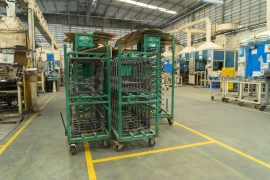Achieving operational excellence in manufacturing is essential for staying ahead of the competition. But it doesn’t mean you need to break the bank. Instead, finding innovative and cost-effective strategies can help you streamline operations and boost productivity. Furthermore, it can reduce waste without sacrificing quality.
In this article, we will walk you through some practical strategies that will help you elevate your manufacturing processes while saving money.
From implementing lean manufacturing principles to discovering affordable used transformers for sale, these tips will provide valuable insights for anyone looking to improve efficiency on a budget.
1. Lean Manufacturing Principles
Lean manufacturing emphasizes creating more value for customers with fewer resources. By applying these principles, you can improve efficiency, reduce waste, and streamline your processes. Here’s how applying these principles can help.
Eliminate Waste: Identify non-value-added processes and eliminate them.
Continuous Improvement (Kaizen): Encourage small, incremental changes that collectively result in significant improvements.
Just-in-Time (JIT): Produce only what is needed, when it’s needed, and in the amount needed to minimize excess inventory.
Implementing Lean Tools
5S System: Sort, Set in Order, Shine, Standardize, and Sustain to organize the workplace.
Kanban: Visual scheduling system to manage production.
2. Energy-Efficient Equipment
Switching to energy-efficient equipment can lead to substantial long-term savings. While initial costs may be higher, the reduced energy consumption quickly balances out the investment.
Energy Star-Rated Machinery: Look for Energy Star certifications when purchasing new equipment.
Lighting Solutions: Replace outdated lighting with LEDs to reduce energy use.
Compressed Air Systems: Upgrade compressors and fix leaks for optimal efficiency.
3. Smart Strategies for Affordable Equipment Sourcing
Purchasing essential equipment can be a major investment, but there are smarter ways to do it without blowing your budget. By sourcing quality pre-owned machinery and electrical components, you can cut costs while maintaining high standards.
However, if your business needs transformers or large machinery, a good practice is to look for pre-owned options to save money that can be invested in other significant areas. When searching for used transformers for sale, it’s important to choose suppliers who provide comprehensive testing and detailed information about each unit. This approach not only provides substantial cost savings but also reduces lead times due to immediate availability.
Finding High-Quality Pre-Owned Equipment
When sourcing used equipment, particularly electrical transformers, consider the following benefits:
Significant Cost Savings: Pre-owned machinery can save you up to 70% compared to buying new units.
Immediate Availability: Unlike new equipment that often requires long lead times, pre-owned units are readily available for quick delivery.
Certified Quality: Reputable dealers test and certify used machinery to ensure it meets industry standards.
Sustainability: Reusing equipment promotes sustainability by reducing waste and conserving resources.
4. Automation and Robotics
Using automation in your production process can significantly enhance efficiency.
Robotic Process Automation (RPA): Use robots for repetitive tasks like welding, painting, and packaging.
Cobots: Collaborative robots work alongside humans for safer, more flexible operations.
Automated Quality Inspection: Deploy machine vision systems to ensure consistent product quality.
5. Preventive Maintenance Programs
Breakdowns and downtime are costly for any manufacturer. A preventive maintenance program can help you minimize these risks.
Routine Inspections: Schedule regular checks to identify issues before they escalate.
Predictive Analytics: Use data to predict equipment failures and schedule maintenance proactively.
Spare Parts Inventory: Keep critical spare parts in stock to reduce downtime during repairs.
Benefits of Preventive Maintenance
- Reduced unplanned downtime
- Longer equipment lifespan
- Lower repair costs
6. Employee Training and Cross-Training
Your workforce is your most valuable asset. Investing in training and development can boost productivity and operational excellence.
Technical Skills Training: Equip employees with the technical skills they need to operate advanced machinery.
Cross-Training: Train employees to perform multiple roles for improved flexibility.
Leadership Development: Prepare future leaders to drive continuous improvement.
Key Training Approaches
On-the-Job Training (OJT): Practical, hands-on training in the production environment.
Online Courses: Affordable access to industry-leading expertise through online platforms.
Mentorship Programs: Pair less experienced employees with seasoned mentors.
Wrapping It All Up
So now you know that achieving operational excellence in manufacturing is a continuous process. If you implement the above-discussed cost-effective strategies, you can easily optimize your operations, reduce waste, and improve productivity without stretching your budget. Whether it’s integrating lean principles, investing in automation, or finding used transformers for sale, every approach plays a crucial role in enhancing your manufacturing excellence. What strategies have you found effective in your journey toward operational excellence? Share your thoughts and experiences in the comments below.





